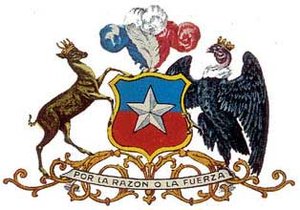Coat of Arms of Chile
|
|
The Coat of Arms of Chile dates from 1834 and was designed by the English artist Charles Wood Taylor. It is made up by a figurative background divided in two equal parts: the top one is blue and the bottom, red. A five pointed white star is in the centre of the shield. This background is supported in one side by a condor, the most significant bird of prey from the Andes, and in the other, by a huemul, the most singular and rare mammal of the Chilean territory. Both animals have in their heads the navy's golden crown, symbol of the heroic deeds of the Chilean Navy in the Pacific Ocean.
The shield is crowned by a three feathered crest; each feather bearing one colour: blue, white and red. This crest was a symbol of distinction that former Presidents of the Republic used to wear on their hats.
Underneath the shiled and on the ellaborated pedestal, there is a white band with the motto: "Por la Razón o la Fuerza" ("By Right or Might").
This emblem is the last of a series of variations due to diverse circumstances and understandings.
The first shield
Chile_Patria_Vieja_shield.png
The first shield was established during the office of President José Miguel Carrera, in 1812. It was designed over an oval in which centre was depicted a column representing the Tree of Freedom. On top of this column was a terrestrial globe; over the globe, a lance and a palm leaf crossed and over these two, a star.
Standing, on both sides of the column, was the figure of a woman and a man, both indigenous. On top of everything was written, in latin, "Post Tenebras Lux" ("After the Darkness, Light") and at the bottom, "Aut Consilio Aut Ense" ("By Counsel or by Word")
In 1817 two new shields emerged, both variations of this last one, but did not last long.
Shield of transition
Chile_transition_shield.png
Two years later, on 23 September 1819, a new project for a shield was approved in the Senate. It was a dark blue field, with a column standing on a white marble pedestal in the middle. On top of this column, the new American world with the word "Freedom" over it. Aboce this sign, a five pointed star, representing the Province of Santiago. Two similar stars, representing Concepción and Coquimbo, were at each side of the column.
This combination of elements was surrounded by two small branches of laurel qwith their buds tied with a tricolour ribbon. Around this ribbon, the whole aromoury of the country was depicted in strict order: cavalry, infantry, dragons, artillery and bombardiers.
To complete the shield, an indigenous man held it with his hands over his head, while sitting on an American caiman with one foot resting on the Horn of Plenty. The caiman had, in its jaws, the Lion of Castille, whose crown laid fallen on one side and was holding the ripped Spanish flag with its front paws.
External link
- Biography of Charles Wood Taylor (http://icarito.latercera.cl/biografias/1831-1861/bios/wood.htm) (in Spanish)

